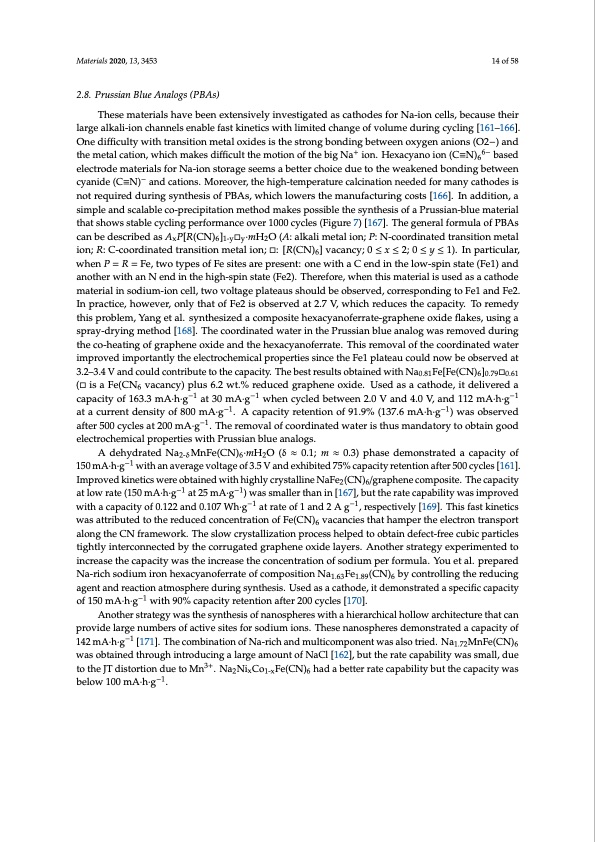
PDF Publication Title:
Text from PDF Page: 014
Materials 2020, 13, 3453 14 of 58 2.8. Prussian Blue Analogs (PBAs) These materials have been extensively investigated as cathodes for Na-ion cells, because their large alkali-ion channels enable fast kinetics with limited change of volume during cycling [161–166]. One difficulty with transition metal oxides is the strong bonding between oxygen anions (O2−) and the metal cation, which makes difficult the motion of the big Na+ ion. Hexacyano ion (C≡N)66− based electrode materials for Na-ion storage seems a better choice due to the weakened bonding between cyanide (C≡N)− and cations. Moreover, the high-temperature calcination needed for many cathodes is not required during synthesis of PBAs, which lowers the manufacturing costs [166]. In addition, a simple and scalable co-precipitation method makes possible the synthesis of a Prussian-blue material that shows stable cycling performance over 1000 cycles (Figure 7) [167]. The general formula of PBAs can be described as AxP[R(CN)6]1-yy·mH2O (A: alkali metal ion; P: N-coordinated transition metal ion; R: C-coordinated transition metal ion; : [R(CN)6] vacancy; 0 ≤ x ≤ 2; 0 ≤ y ≤ 1). In particular, when P = R = Fe, two types of Fe sites are present: one with a C end in the low-spin state (Fe1) and another with an N end in the high-spin state (Fe2). Therefore, when this material is used as a cathode material in sodium-ion cell, two voltage plateaus should be observed, corresponding to Fe1 and Fe2. In practice, however, only that of Fe2 is observed at 2.7 V, which reduces the capacity. To remedy this problem, Yang et al. synthesized a composite hexacyanoferrate-graphene oxide flakes, using a spray-drying method [168]. The coordinated water in the Prussian blue analog was removed during the co-heating of graphene oxide and the hexacyanoferrate. This removal of the coordinated water improved importantly the electrochemical properties since the Fe1 plateau could now be observed at 3.2–3.4 V and could contribute to the capacity. The best results obtained with Na0.81Fe[Fe(CN)6]0.790.61 ( is a Fe(CN6 vacancy) plus 6.2 wt.% reduced graphene oxide. Used as a cathode, it delivered a capacity of 163.3 mA·h·g−1 at 30 mA·g−1 when cycled between 2.0 V and 4.0 V, and 112 mA·h·g−1 at a current density of 800 mA·g−1. A capacity retention of 91.9% (137.6 mA·h·g−1) was observed after 500 cycles at 200 mA·g−1. The removal of coordinated water is thus mandatory to obtain good electrochemical properties with Prussian blue analogs. A dehydrated Na2-δMnFe(CN)6·mH2O (δ ≈ 0.1; m ≈ 0.3) phase demonstrated a capacity of 150 mA·h·g−1 with an average voltage of 3.5 V and exhibited 75% capacity retention after 500 cycles [161]. Improved kinetics were obtained with highly crystalline NaFe2(CN)6/graphene composite. The capacity at low rate (150 mA·h·g−1 at 25 mA·g−1) was smaller than in [167], but the rate capability was improved with a capacity of 0.122 and 0.107 Wh·g−1 at rate of 1 and 2 A g−1, respectively [169]. This fast kinetics was attributed to the reduced concentration of Fe(CN)6 vacancies that hamper the electron transport along the CN framework. The slow crystallization process helped to obtain defect-free cubic particles tightly interconnected by the corrugated graphene oxide layers. Another strategy experimented to increase the capacity was the increase the concentration of sodium per formula. You et al. prepared Na-rich sodium iron hexacyanoferrate of composition Na1.63Fe1.89(CN)6 by controlling the reducing agent and reaction atmosphere during synthesis. Used as a cathode, it demonstrated a specific capacity of 150 mA·h·g−1 with 90% capacity retention after 200 cycles [170]. Another strategy was the synthesis of nanospheres with a hierarchical hollow architecture that can provide large numbers of active sites for sodium ions. These nanospheres demonstrated a capacity of 142 mA·h·g−1 [171]. The combination of Na-rich and multicomponent was also tried. Na1.72MnFe(CN)6 was obtained through introducing a large amount of NaCl [162], but the rate capability was small, due to the JT distortion due to Mn3+. Na2NixCo1-xFe(CN)6 had a better rate capability but the capacity was below 100 mA·h·g−1.PDF Image | Electrode Materials for Sodium-Ion Batteries

PDF Search Title:
Electrode Materials for Sodium-Ion BatteriesOriginal File Name Searched:
materials-13-03453-v2.pdfDIY PDF Search: Google It | Yahoo | Bing
Salgenx Redox Flow Battery Technology: Salt water flow battery technology with low cost and great energy density that can be used for power storage and thermal storage. Let us de-risk your production using our license. Our aqueous flow battery is less cost than Tesla Megapack and available faster. Redox flow battery. No membrane needed like with Vanadium, or Bromine. Salgenx flow battery
| CONTACT TEL: 608-238-6001 Email: greg@salgenx.com | RSS | AMP |